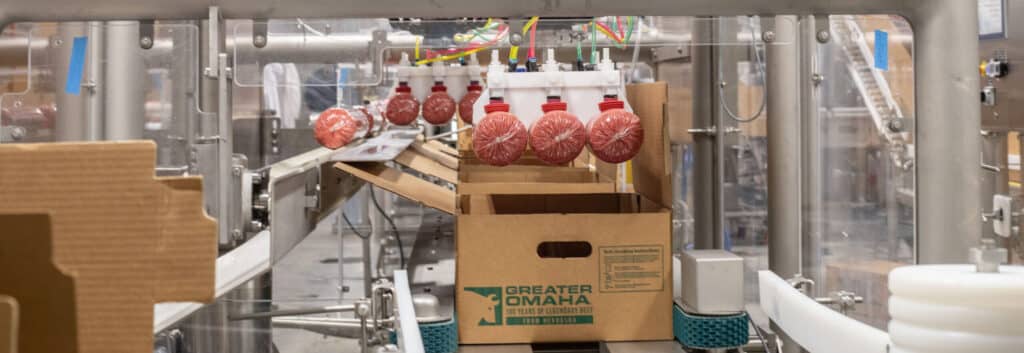Operational Efficiency at Greater Omaha Packing
DATA ANALYSIS
For many meat and poultry processors, optimizing data capture and analysis helps dial in the most optimal solutions when it comes to meeting sustainability goals and delivering a better end product. Connecting information to a network of suppliers and partners in an easily accessible place can have a ripple effect on other business considerations and can make operations run more smoothly for all stakeholders.
Data analysis and management platforms can go a long way for meat processors looking for ways to automate to enable workers to spend less time on processes and more time on improving the products themselves.
“For meat processors that implement digital technology like a specification data management platform, those companies can spend less time on manual data entry and more time on things like product innovation, sustainability initiatives, procurement and cost-savings initiatives and quality assurance,” Wright said. “This can lead to producing more sustainable products, reduced waste and fewer product recalls due to things like mislabeling.”
Hard hat, Smile, Helmet, Workwear, White, Sleeve, Engineer
“Advanced technology and automation allows Greater Omaha Packing to utilize our valuable employees in smarter, safer jobs that are less physically demanding.” says Ryan Abell, vice president of operations at Greater Omaha Packing.
CHIEF EDITOR
BY FRED WILKINSON
NATIONAL PROVISIONER
JANUARY 2023
Striving for operational efficiency necessarily involves every part of the business, whether it be sustainability considerations or relations with suppliers and customers. Ultimately, operational efficiency means reducing waste in time, effort and materials – beginning with the design of facility itself.
“When facilities consider safety and sustainability during the design phase, they are likely to create workflows and select equipment and material that keep processing plants operating smoothly and employees performing tasks with speed and confidence,” said Matthew Wright, founder and CEO of Specright, a cloud-based platform that manages specification data across the supply chain.
Facility design plays a critical role in operational efficiency for meat processing, especially as it relates to employee safety and related liability issues, said Andrew Scott, senior account executive for SLIPNOT, a manufacturer of specialized safety surface technologies.
“On average, companies spend around $48,000 per falls or slips on workers compensation costs,” Scott said. “The best time to plan for safety is in the design phase. Due to the wet nature of meat processing, workers are 25% more likely to suffer a slip and fall at work.”
Special consideration should be given to all areas where high concentrations of contaminants are present, said Scott, who is certified by the National Association of Safety Professionals as a Walking-Working Surfaces and Fall Protection Specialist.
“Drains and trenches positioned under and around processing and cutting lines are high-risk areas for slips and falls,” he said. “This is where greasy animal proteins, fats and blood collect, creating wet and slippery spots that increase the likelihood employees will slip and fall.”
Other key areas for fall risk include mezzanines on which production takes place, catwalks and platforms along production lines, and locations where contaminants may be carried or tracked via foot traffic, such as stairs, ladders or highly trafficked areas outside of production areas such as common areas, cafeterias, locker rooms and bathrooms.
Scott said well-planned meat processing facilities consider the movements of all the workers, from workers on the processing line to the crews coming in to clean and sanitize.
“If employees take alternative routes to avoid slippery areas or have to tread cautiously up a wet staircase to reduce the risk of slipping, this can add up to a significant amount of lost time over the course of a year,” he said. “Accounting for these elements in the design phase can result in huge efficiency gains by keeping processing lines operational, versus shutting lines down to make adjustments after the fact.”
Materials selected during the facility design phase also influence operational efficiency, sustainability and safety.
“When the facility and safety teams select equipment and materials that provide superior, long-term performance, they reduce downtime and team time sacrificed by audits, the expenses of purchasing replacement materials and the unnecessary waste of disposing of materials that don’t last,” Wright said. “More importantly, if a walking surface material reduces the risk of slips and falls, the number of accidents is reduced as well as the operational downtime that results from those incidents.”
Wright suggests seeking advice from safety experts and specifying engineers during the design and planning stage, as they can give feedback and share insights from projects at other meat processing facilities that can help save time and money.
EFFORTS ENSURE OPERATIONS GET THE MOST OUT OF THEIR PEOPLE AND PROCESSES.
Data also can help with employee engagement and retention.
“We can identify areas that have higher absenteeism or greater turnover and drive back to the root cause,” said Ryan Abell, vice president of operations at beef processor Greater Omaha Packing. “We are able to identify areas of underperformance from both an equipment and employee standpoint. We constantly evaluate and analyze yields with real-time data to make adjustments that are immediately relevant to the business.”
Data collection and analysis also can guide development of new products for meat processors.
“By removing manual data processes and utilizing a spec-first approach, meat processors are able to accelerate the speed to market by gaining comprehensive visibility into all the data that helps bring their products to life,” Wright said. “This results in faster product diversification, which leads to more revenue for these companies. Today, there is also great emphasis on sustainability of new products, and managing this data up front brings greater clarity to the total carbon footprint of a product by being able to easily conduct life cycle assessments.”
The drive for efficiency often opens the doors for more sustainable practices and products, Abell said. “Efficiencies can ignite a customer or supplier conversation as we work to develop a new product or identify an opportunity for cost savings.”
AUTOMATION
Automation plays an important role in augmenting operational efficiency, employing robotics and other processing and handling technologies to maximize throughput while helping to mitigate challenging staffing issues that persist for many packing operations.
“Our automated distribution center helps us know that our box, customer service and delivery match the superior quality of our beef and pork products,” said Jim Rogers, senior vice president, sales, for Creekstone Farms. “Trained employees are valuable to every meat industry operation. However, automation has allowed us to improve our operations even beyond the most trained employee. We’re using our team member time more effectively and reducing the risk of injury all while reducing human error in picking customer orders.”
In 2020, Creekstone Farms’ opened a new distribution center at its Arkansas City, Kan., facility. At roughly 42,000 square feet, the warehouse houses 20 rotating carousels with a capacity for 72,000 boxes of beef. This automation enables filling orders in as little as 20 minutes with 99.9% order accuracy, all with less than 30 minutes of down time in the entire year, Rogers said.
“We have doubled our truckload output and improved our product and package quality,” he said. “No one touches a box after it leaves fabrication. It’s handled entirely by robotics and software that creates a 3D visualization of the entire warehouse and where each box is located.”
Building the distribution center has become a channel for growth for Creekstone Farms, Rogers said. The project expanded the fabrication area, doubled its all-indoor cattle holding system and repurposed an old distribution area to expand trim operations.
Automation is key for not only production efficiencies, but also for worker safety, Abell said.
“It also plays a big part in ensuring we are well-staffed and making up for worker absences,” Abell said. “Advanced technology and automation allows Greater Omaha Packing to utilize our valuable employees in smarter, safer jobs that are less physically demanding. With automation playing a stronger role in critical tasks that affect our chain speed, automation and technology offer us flexibility as to how and where we position our employees without affecting our efficiencies.”
Employee training is a big focus at Greater Omaha Packing, Abell said, adding that, “Well-trained employees are able to perform their jobs more efficiently, resulting in greater overall operational efficiencies.”
He said automation has increased the importance of employee training and has opened up opportunities to cross-train employees on a wider variety of jobs.
“This not only helps from an operational efficiency standpoint, but also provides our employees with more advancement opportunities and job satisfaction,” he said.
Facility design is essential in governing flow and efficiency at Greater Omaha Packing, Abell said, where 1,500 employees process 2,400 cattle per day.
Through a recent $20 million USDA grant, Greater Omaha Packing is planning a $100 million investment to process an additional 700 head of cattle per day, he said. The expansion will upgrade and automate freezers, expand carcass-holding coolers, increase wastewater system capacity and remodel the value-added processing area.


